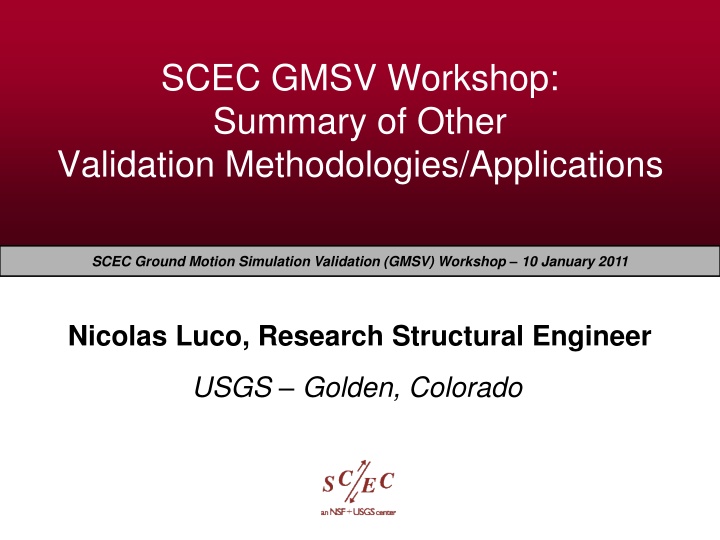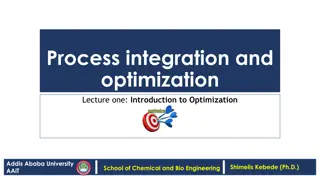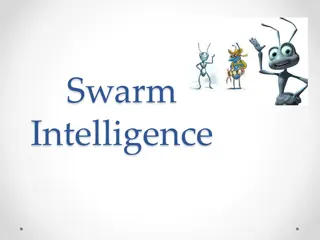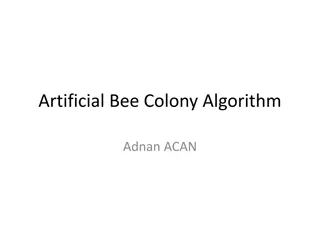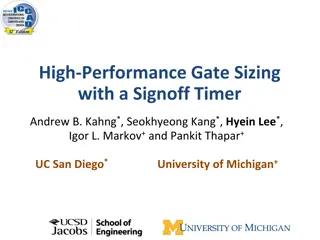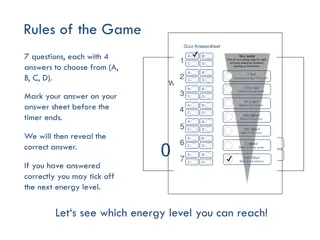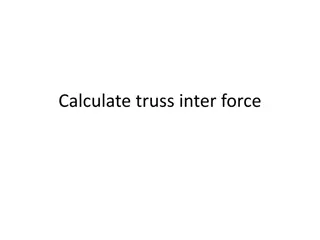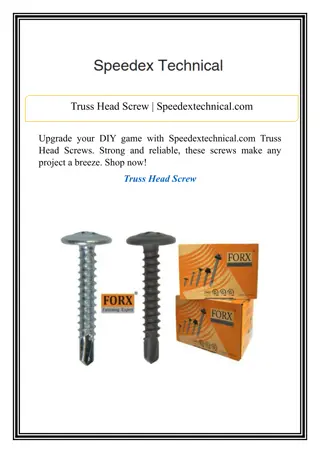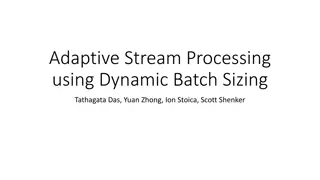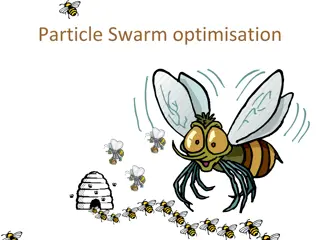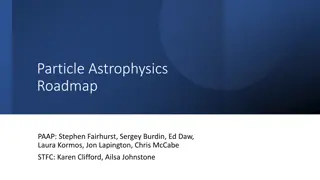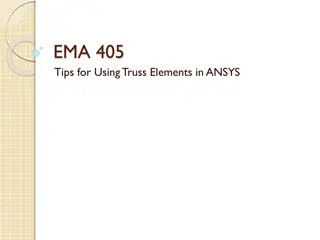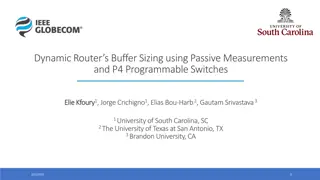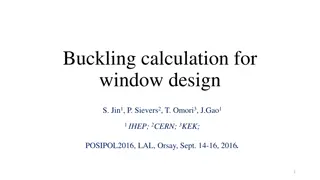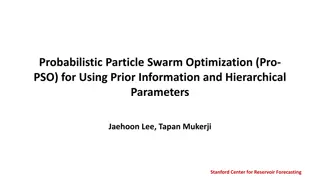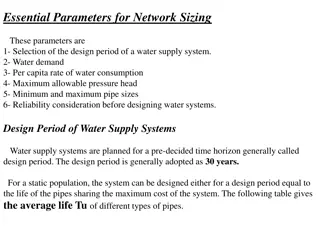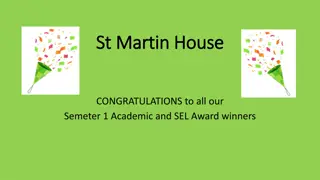Particle Swarm Optimization for Truss Sizing with Buckling Constraints
This paper discusses the use of particle swarm optimization algorithm for planar truss sizing with dynamic buckling constraints, focusing on minimizing total structure mass and surface area. It delves into truss structural optimization, buckling constraints, and the application of PSO in achieving optimal designs. The study compares different models to analyze the impact of mass minimization on reducing overall construction costs.
Download Presentation

Please find below an Image/Link to download the presentation.
The content on the website is provided AS IS for your information and personal use only. It may not be sold, licensed, or shared on other websites without obtaining consent from the author.If you encounter any issues during the download, it is possible that the publisher has removed the file from their server.
You are allowed to download the files provided on this website for personal or commercial use, subject to the condition that they are used lawfully. All files are the property of their respective owners.
The content on the website is provided AS IS for your information and personal use only. It may not be sold, licensed, or shared on other websites without obtaining consent from the author.
E N D
Presentation Transcript
SCEC GMSV Workshop: Summary of Other Validation Methodologies/Applications EERI Seminar on Next Generation Attenuation Models SCEC Ground Motion Simulation Validation (GMSV) Workshop 10 January 2011 Nicolas Luco, Research Structural Engineer USGS Golden, Colorado
Outline 2010 SCEC Project: Goulet & Haselton LA Tall Buildings Seismic Design Council (LATBSDC): Zareian & Jones FY10 USGS External Research Project: van de Lindt & Pei (in collaboration w/ Hartzell & Luco) 2004 PEER Project: Bazzurro, Sjoberg, & Luco Others? EERI Seminar on Next Generation Attenuation Models SCEC Ground Motion Simulation Validation (GMSV) Workshop Summary of Other Validation Methodologies/Applications, N. Luco, USGS January 10, 2011
2010 SCEC Project: Goulet & Haselton Comparing responses of multi-story building models subjected to simulated & recorded ground motions Using simulated motions whose response spectra are similar to recorded ones, in 3 different ways 1) One-to-one matching (pairwise) EERI Seminar on Next Generation Attenuation Models SCEC Ground Motion Simulation Validation (GMSV) Workshop Summary of Other Validation Methodologies/Applications, N. Luco, USGS January 10, 2011
2010 SCEC Project: Goulet & Haselton Comparing responses of multi-story building models subjected to simulated & recorded ground motions Using simulated motions whose response spectra are similar to recorded ones, in 3 different ways 1) One-to-one matching (pairwise) EERI Seminar on Next Generation Attenuation Models SCEC Ground Motion Simulation Validation (GMSV) Workshop Summary of Other Validation Methodologies/Applications, N. Luco, USGS January 10, 2011
2010 SCEC Project: Goulet & Haselton From 2010 SCEC Annual Meeting poster Figure 1: Example of record selection for the one-to-one comparison. Five best matches to the El Centro 180 degrees component from 3660 simulated Landers records. Selection is based on optimization of the mean square error relative to the target. EERI Seminar on Next Generation Attenuation Models SCEC Ground Motion Simulation Validation (GMSV) Workshop Summary of Other Validation Methodologies/Applications, N. Luco, USGS January 10, 2011
2010 SCEC Project: Goulet & Haselton EERI Seminar on Next Generation Attenuation Models SCEC Ground Motion Simulation Validation (GMSV) Workshop Summary of Other Validation Methodologies/Applications, N. Luco, USGS January 10, 2011
2010 SCEC Project: Goulet & Haselton Comparing responses of multi-story building models subjected to simulated & recorded ground motions Using simulated motions whose response spectra are similar to recorded ones, in 3 different ways 1) One-to-one matching (pairwise) 2) Sets matched to Uniform-Hazard Spectrum 3) Sets matched to Conditional Mean Spectrum EERI Seminar on Next Generation Attenuation Models SCEC Ground Motion Simulation Validation (GMSV) Workshop Summary of Other Validation Methodologies/Applications, N. Luco, USGS January 10, 2011
2010 SCEC Project: Goulet & Haselton From 2010 SCEC Annual Meeting poster Figure 2: The two different types of response spectra used in comparisons 2 and 3 (Building B shown as an example). EERI Seminar on Next Generation Attenuation Models SCEC Ground Motion Simulation Validation (GMSV) Workshop Summary of Other Validation Methodologies/Applications, N. Luco, USGS January 10, 2011
LATBSDC: Zareian Comparing responses of tall building models subjected to simulated & recorded ground motions Using motions whose response spectra are matched to Uniform-Hazard Spectrum (5 RP s) EERI Seminar on Next Generation Attenuation Models SCEC Ground Motion Simulation Validation (GMSV) Workshop Summary of Other Validation Methodologies/Applications, N. Luco, USGS January 10, 2011
Response Spectra OVE (4975 year) Sa(T) Rec Sim Med. Rec. Med. Sim. Target E-W Period Sa(T) N-S
LATBSDC: Zareian Comparing responses of tall building models subjected to simulated & recorded ground motions Using motions whose response spectra are matched to Uniform-Hazard Spectrum (5 RP s) Conclusion (partial): Differences in peak story drifts can (mostly) be traced back to differences in response spectra, but phasing differences linger. EERI Seminar on Next Generation Attenuation Models SCEC Ground Motion Simulation Validation (GMSV) Workshop Summary of Other Validation Methodologies/Applications, N. Luco, USGS January 10, 2011
Comparison of IDR time histories simulated vs recorded: How was the IDR envelope developed? A.) B.)
FY10 USGS Project: van de Lindt & Pei Compared Damage Potential Indicators (DPI s) for simulated & recorded ground motions Used simulated motions (from Frankel, Hartzell, Liu, & Zeng) for Northridge, Loma Prieta, & Izmit recording stations Conclusions: Accuracy of simulations depends on strength of building, in addition to vibration period Accuracy can be sensitive to source distance, site class, spectral acceleration level, and ground motion model EERI Seminar on Next Generation Attenuation Models SCEC Ground Motion Simulation Validation (GMSV) Workshop Summary of Other Validation Methodologies/Applications, N. Luco, USGS January 10, 2011
FY10 USGS Project: van de Lindt & Pei From paper submitted to Earthquake Spectra EERI Seminar on Next Generation Attenuation Models SCEC Ground Motion Simulation Validation (GMSV) Workshop Summary of Other Validation Methodologies/Applications, N. Luco, USGS January 10, 2011
FY10 USGS Project: van de Lindt & Pei Compared Damage Potential Indicators (DPI s) for simulated & recorded ground motions Used simulated motions (from Frankel, Hartzell, Liu, & Zeng) for Northridge, Loma Prieta, & Izmit recording stations Conclusions: Accuracy of simulations depends on strength of building, in addition to vibration period Accuracy can be sensitive to source distance, site class, spectral acceleration level, and ground motion model EERI Seminar on Next Generation Attenuation Models SCEC Ground Motion Simulation Validation (GMSV) Workshop Summary of Other Validation Methodologies/Applications, N. Luco, USGS January 10, 2011
FY10 USGS Project: van de Lindt & Pei From paper submitted to Earthquake Spectra Figure 16. Distribution of Delta-DPI for synthetic motions with accurate Sa value at building period EERI Seminar on Next Generation Attenuation Models SCEC Ground Motion Simulation Validation (GMSV) Workshop Summary of Other Validation Methodologies/Applications, N. Luco, USGS January 10, 2011
2004 PEER Project: Bazzurro et al Compared elastic (Sa) & nonlinear (Sdi) response spectra, & inelastic-to-elastic spectral ratio (C=Sdi/Sa) for simulated & recorded ground motions Used simulated motions (from Beresnev, Dreger, Gusev, Hutchings/LLNL, Silva, Somerville/URS, & Zeng) for 20 Northridge recording stations Conclusions: Biases in shape of elastic response spectra resulted in biases in inelastic-to-elastic spectral ratio (C) Systematic differences in variability of C EERI Seminar on Next Generation Attenuation Models SCEC Ground Motion Simulation Validation (GMSV) Workshop Summary of Other Validation Methodologies/Applications, N. Luco, USGS January 10, 2011
2004 PEER Project: Bazzurro et al Project 1G00 Addenda From PEER Report on (pp. 65-112) EERI Seminar on Next Generation Attenuation Models SCEC Ground Motion Simulation Validation (GMSV) Workshop Summary of Other Validation Methodologies/Applications, N. Luco, USGS January 10, 2011
2004 PEER Project: Bazzurro et al Project 1G00 Addenda From PEER Report on (pp. 65-112) EERI Seminar on Next Generation Attenuation Models SCEC Ground Motion Simulation Validation (GMSV) Workshop Summary of Other Validation Methodologies/Applications, N. Luco, USGS January 10, 2011
Outline 2010 SCEC Project: Goulet & Haselton LA Tall Buildings Seismic Design Council (LATBSDC): Zareian & Jones FY10 USGS External Research Project: van de Lindt & Pei (in collaboration w/ Hartzell & Luco) 2004 PEER Project: Bazzurro, Sjoberg, & Luco Others? EERI Seminar on Next Generation Attenuation Models SCEC Ground Motion Simulation Validation (GMSV) Workshop Summary of Other Validation Methodologies/Applications, N. Luco, USGS January 10, 2011
FY10 USGS Project: van de Lindt & Pei From paper submitted to Earthquake Spectra EERI Seminar on Next Generation Attenuation Models SCEC Ground Motion Simulation Validation (GMSV) Workshop Summary of Other Validation Methodologies/Applications, N. Luco, USGS January 10, 2011
